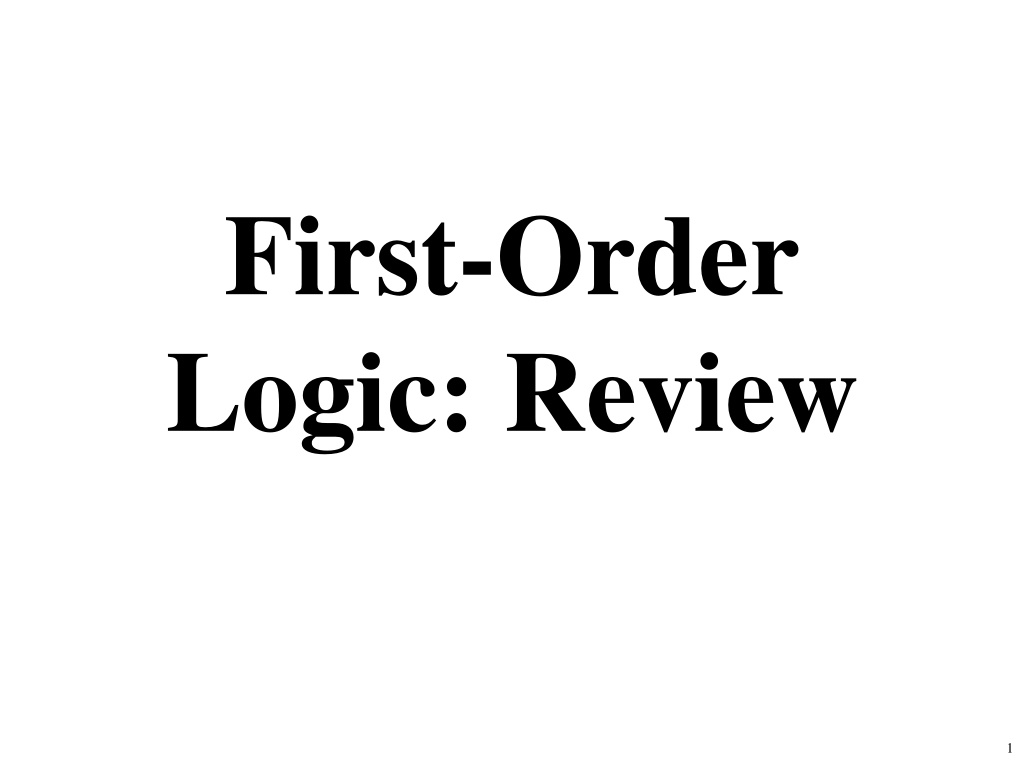
Understanding First-Order Logic Concepts
Explore the fundamentals of First-Order Logic (FOL) including objects, properties, functions, constants, variables, connectives, quantifiers, and building sentences. Learn how FOL models the world and represents relationships between entities.
Download Presentation

Please find below an Image/Link to download the presentation.
The content on the website is provided AS IS for your information and personal use only. It may not be sold, licensed, or shared on other websites without obtaining consent from the author. If you encounter any issues during the download, it is possible that the publisher has removed the file from their server.
You are allowed to download the files provided on this website for personal or commercial use, subject to the condition that they are used lawfully. All files are the property of their respective owners.
The content on the website is provided AS IS for your information and personal use only. It may not be sold, licensed, or shared on other websites without obtaining consent from the author.
E N D
Presentation Transcript
First-Order Logic: Review 1
First-order logic First-order logic (FOL) models the world in terms of Objects, which are things with individual identities Properties of objects that distinguish them from others Relations that hold among sets of objects Functions, which are a subset of relations where there is only one value for any given input Examples: Objects: Students, lectures, companies, cars ... Relations: Brother-of, bigger-than, outside, part-of, has- color, occurs-after, owns, visits, precedes, ... Properties: blue, oval, even, large, ... Functions: father-of, best-friend, second-half, more-than ...
User provides Constant symbols representing individuals in the world Mary, 3, green Function symbols, map individuals to individuals father_of(Mary) = John color_of(Sky) = Blue Predicate symbols, map individuals to truth values greater(5,3) green(Grass) color(Grass, Green)
FOL Provides Variable symbols E.g., x, y, foo Connectives Same as in propositional logic: not ( ), and ( ), or ( ), implies ( ), iff ( ) Quantifiers Universal x or (Ax) Existential x or (Ex)
Sentences: built from terms and atoms A term (denoting a real-world individual) is a constant symbol, variable symbol, or n-place function of n terms, e.g.: Constants: john, umbc Variables: x, y, z Functions: mother_of(john), phone(mother(x)) Ground terms have no variables in them Ground: john, father_of(father_of(john)) Not Ground: father_of(X)
Sentences: built from terms and atoms An atomic sentence (which has value true or false) is an n-place predicate of n terms, e.g.: green(Kermit)) between(Philadelphia, Baltimore, DC) loves(X, mother(X)) A complex sentence is formed from atomic sentences connected by logical connectives: P, P Q, P Q, P Q, P Q where P and Q are sentences
Sentences: built from terms and atoms quantified sentences adds quantifiers and x loves(x, mother(x)) x number(x) greater(x, 100), prime(x) A well-formed formula (wff) is a sentence containing no free variables, i.e., all variables are bound by either a universal or existential quantifiers ( x)P(x,y) has x bound as a universally quantified variable, but y is free
Quantifiers Universal quantification ( x)P(x) means P holds for all values of x in domain associated with variable E.g., ( x) dolphin(x) mammal(x) Existentialquantification ( x)P(x) means P holds for some value of x in domain associated with variable E.g., ( x) mammal(x) lays_eggs(x) This lets us make a statement about some object without naming it
Quantifiers (1) Universal quantifiers often used with implies to form rules: ( x) student(x) smart(x) means All students are smart Universal quantification rarely used to make blanket statements about every individual in the world: ( x) student(x) smart(x) means Everyone in the world is a student and is smart
Quantifiers (2) Existential quantifiers usually used with and to specify a list of properties about an individual: ( x) student(x) smart(x) means There is a student who is smart Common mistake: represent this in FOL as: ( x) student(x) smart(x) What does this sentence mean? ??
Quantifier Scope FOL sentences have structure, like programs In particular, the variables in a sentence have a scope For example, suppose we want to say everyone who is alive loves someone ( x) alive(x) ( y) loves(x,y) Here s how we scope the variables ( x) alive(x) ( y) loves(x,y) Scope of x Scope of y
Quantifier Scope Switching order of universal quantifiers does not change the meaning ( x)( y)P(x,y) ( y)( x) P(x,y) Dogs hate cats (i.e., all dogs hate all cats ) You can switch order of existential quantifiers ( x)( y)P(x,y) ( y)( x) P(x,y) A cat killed a dog Switching order of universal and existential quantifiers does change meaning: Everyone likes someone: ( x)( y) likes(x,y) Someone is liked by everyone: ( y)( x) likes(x,y)
Procedural example 1 def verify1(): # Everyone likes someone: ( x)( y) likes(x,y) for x in people(): found = False for y in people(): if likes(x,y): found = True break if not Found: return False return True Every person has at least one individual that they like.
Procedural example 2 def verify2(): # Someone is liked by everyone: ( y)( x) likes(x,y) for y in people(): found = True for x in people(): if not likes(x,y): found = False break if found return True return False There is a person who is liked by every person in the universe.
Connections between and We can relate sentences involving and using extensions to De Morgan s laws: 1.( x) P(x) ( x) P(x) 2. ( x) P ( x) P(x) 3.( x) P(x) ( x) P(x) 4.( x) P(x) ( x) P(x) Examples 1. All dogs don t like cats No dogs like cats 2. Not all dogs dance There is a dog that doesn t dance 3. All dogs sleep There is no dog that doesn t sleep 4. There is a dog that talks Not all dogs can t talk
Quantified inference rules Universal instantiation x P(x) P(A) # where A is some constant Universal generalization P(A) P(B) x P(x) # if AB enumerate all # individuals Existential instantiation x P(x) P(F) Existential generalization P(A) x P(x) Skolem* constant F F must be a new constant not appearing in the KB * After Thoralf Skolem
Universal instantiation (a.k.a. universal elimination) If ( x) P(x) is true, then P(C) is true, where C is any constant in the domain of x, e.g.: ( x) eats(John, x) eats(John, Cheese18) Note that function applied to ground terms is also a constant ( x) eats(John, x) eats(John, contents(Box42))
Existential instantiation (a.k.a. existential elimination) From ( x) P(x) infer P(c), e.g.: ( x) eats(Mikey, x) eats(Mikey, Stuff345) The variable is replaced by a brand-new constant not occurring in this or any sentence in the KB Also known as skolemization; constant is a skolem constant We don t want to accidentally draw other inferences about it by introducing the constant Can use this to reason about unknown objects, rather than constantly manipulating existential quantifiers
Existential generalization (a.k.a. existential introduction) If P(c) is true, then ( x) P(x) is inferred, e.g.: Eats(Mickey, Cheese18) ( x) eats(Mickey, x) All instances of the given constant symbol are replaced by the new variable symbol Note that the variable symbol cannot already exist anywhere in the expression
Translating English to FOL Every gardener likes the sun x gardener(x) likes(x,Sun) You can fool some of the people all of the time x t person(x) time(t) can-fool(x, t) You can fool all of the people some of the time t time(t) x person(x) can-fool(x, t) x person(x) t time(t) can-fool(x, t) All purple mushrooms are poisonous x (mushroom(x) purple(x)) poisonous(x) Note 2 possible readings of NL sentence
Translating English to FOL No purple mushroom is poisonous (two ways) x purple(x) mushroom(x) poisonous(x) x (mushroom(x) purple(x)) poisonous(x) There are exactly two purple mushrooms x y mushroom(x) purple(x) mushroom(y) purple(y) (x=y) z (mushroom(z) purple(z)) ((x=z) (y=z)) Obama is not short short(Obama)
Simple genealogy KB in FOL Design a knowledge base using FOL that Has facts of immediate family relations, e.g., spouses, parents, etc. Defines of more complex relations (ancestors, relatives) Detect conflicts, e.g., you are your own parent Infers relations, e.g., grandparernt from parent Answers queries about relationships between people
How do we approach this? Design an initial ontology of types, e.g. e.g., person, man, woman, gender Add general individuals to ontology, e.g. gender(male), gender(female) Extend ontology be defining relations, e.g. spouse, has_child, has_parent Add general constraints to relations, e.g. spouse(X,Y) => ~ X = Y spouse(X,Y) => person(X), person(Y) Add FOL sentences for inference, e.g. spouse(X,Y) spouse(Y,X) man(X) person(X) has_gender(X, male)
Simple genealogy KB in FOL Has facts of immediate family relations, e.g., spouses, parents, etc. Has definitions of more complex relations (ancestors, relatives) Can detect conflicts, e.g., you are your own parent Can infer relations, e.g., grandparernt from parent Can answer queries about relationships between people
Example: A simple genealogy KB by FOL Predicates: parent(x, y), child(x, y), father(x, y), daughter(x, y), etc. spouse(x, y), husband(x, y), wife(x,y) ancestor(x, y), descendant(x, y) male(x), female(y) relative(x, y) Facts: husband(Joe, Mary), son(Fred, Joe) spouse(John, Nancy), male(John), son(Mark, Nancy) father(Jack, Nancy), daughter(Linda, Jack) daughter(Liz, Linda) etc.
Example Axioms ( x,y) has_parent(x, y) has_child (y, x) ( x,y) father(x, y) parent(x, y) male(x) ;similar for mother(x, y) ( x,y) daughter(x, y) child(x, y) female(x) ;similar for son(x, y) ( x,y) husband(x, y) spouse(x, y) male(x) ;similar for wife(x, y) ( x,y) spouse(x, y) spouse(y, x) ;spouse relation is symmetric ( x,y) parent(x, y) ancestor(x, y) ( x,y)( z) parent(x, z) ancestor(z, y) ancestor(x, y) ( x,y) descendant(x, y) ancestor(y, x) ( x,y)( z) ancestor(z, x) ancestor(z, y) relative(x, y) ( x,y) spouse(x, y) relative(x, y) ;related by marriage ( x,y)( z) relative(z, x) relative(z, y) relative(x, y) ;transitive ( x,y) relative(x, y) relative(y, x) ;symmetric
Rules for genealogical relations ( x,y) parent(x, y) child (y, x) ( x,y) father(x, y) parent(x, y) male(x) ;similarly for mother(x, y) ( x,y) daughter(x, y) child(x, y) female(x) ;similarly for son(x, y) ( x,y) husband(x, y) spouse(x, y) male(x) ;similarly for wife(x, y) ( x,y) spouse(x, y) spouse(y, x) ;spouse relation is symmetric ( x,y) parent(x, y) ancestor(x, y) ( x,y)( z) parent(x, z) ancestor(z, y) ancestor(x, y) ( x,y) descendant(x, y) ancestor(y, x) ( x,y)( z) ancestor(z, x) ancestor(z, y) relative(x, y) ;related by common ancestry ( x,y) spouse(x, y) relative(x, y) ;related by marriage ( x,y)( z) relative(z, x) relative(z, y) relative(x, y) ;transitive ( x,y) relative(x, y) relative(y, x) ;symmetric Queries ancestor(Jack, Fred) ; the answer is yes relative(Liz, Joe) ; the answer is yes relative(Nancy, Matthew) ;no answer, no under closed world assumption ( z) ancestor(z, Fred) ancestor(z, Liz)
Axioms, definitions and theorems Axioms: facts and rules that capture the (important) facts and concepts about a domain; axioms can be used to prove theorems Mathematicians dislike unnecessary (dependent) axioms, i.e. ones that can be derived from others Dependent axioms can make reasoning faster, however Choosing a good set of axioms is a design problem A definition of a predicate is of the form p(X) and can be decomposed into two parts Necessary description: p(x) Sufficient description p(x) Some concepts have definitions (triangle) and some do not (person)
More on definitions Example: define father(x, y) by parent(x, y) and male(x) parent(x, y) is a necessary (but not sufficient) description of father(x, y) father(x, y) parent(x, y) parent(x, y) ^ male(x) ^ age(x, 35) is a sufficient (but not necessary) description of father(x, y): father(x, y) parent(x, y) ^ male(x) ^ age(x, 35) parent(x, y) ^ male(x) is a necessary and sufficient description of father(x, y) parent(x, y) ^ male(x) father(x, y)
More on definitions S(x) is a necessary condition of P(x) P(x) ( x) P(x) => S(x) S(x) S(x) is a sufficient condition of P(x) S(x) ( x) P(x) <= S(x) P(x) S(x) is a necessary and sufficient condition of P(x) P(x) ( x) P(x) <=> S(x) S(x)
Higher-order logic FOL only lets us quantify over variables, and variables can only range over objects HOL allows us to quantify over relations, e.g. two functions are equal iff they produce the same value for all arguments f g (f = g) ( x f(x) = g(x)) E.g.: (quantify over predicates) r transitive( r ) ( xyz) r(x,y) r(y,z) r(x,z)) More expressive, but undecidable, in general
Expressing uniqueness Often want to say that there is a single, unique object that satisfies a condition There exists a unique x such that king(x) is true x king(x) y (king(y) x=y) x king(x) y (king(y) x y) ! x king(x) Every country has exactly one ruler c country(c) ! r ruler(c,r) Iota operator: x P(x) means the unique x such that p(x) is true The unique ruler of Freedonia is dead dead( x ruler(freedonia,x)) syntactic sugar
Notational differences Different symbols for and, or, not, implies, ... p v (q ^ r) p + (q * r) Prolog cat(X) :- furry(X), meows (X), has(X, claws) Lispy notations (forall ?x (implies (and (furry ?x) (meows ?x) (has ?x claws)) (cat ?x)))
A example of FOL in use Semantics of W3C s semantic web stack (RDF, RDFS, OWL) is defined in FOL OWL Full is equivalent to FOL Other OWL profiles support a subset of FOL and are more efficient However, the semantics of schema.org is only defined in natural language text and Google s knowledge Graph probably (!) uses probabilities 47
FOL Summary First order logic (FOL) introduces predicates, functions and quantifiers More expressive, but reasoning more complex Reasoning in propositional logic is NP hard, FOL is semi-decidable Common AI knowledge representation language Other KR languages (e.g., OWL) are often defined by mapping them to FOL FOL variables range over objects HOL variables range over functions, predicates or sentences




